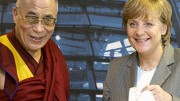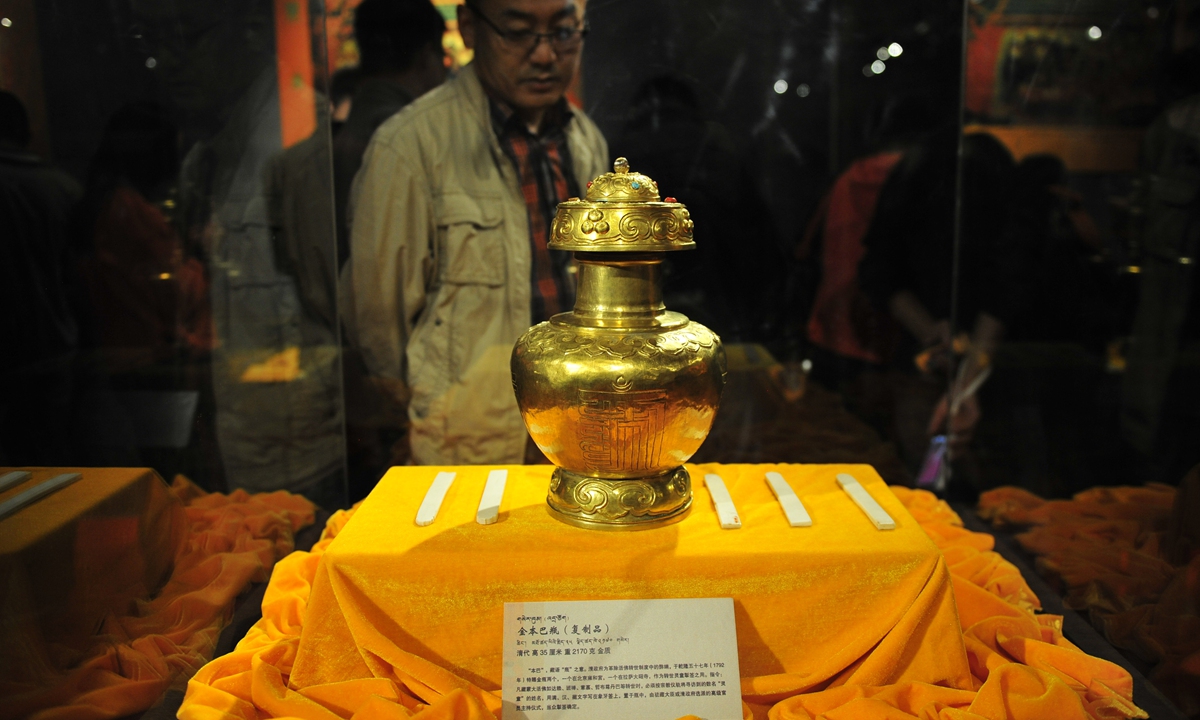Free Tibet? China bereitet sich auf den Tod des Dalai Lama vor
Vor lauter Xinjiang und Uiguren war jetzt schon lange nichts mehr über Tibet in der Global Times, wie auch über den Dalai Lama im Westen. Nachdem der Dalai Lama noch in den 90er und 2000ern gerne von westlichen Politikern empfangen wurde, führte der Druck Pekings und die Aussischt auf den chinesischen Supermarkt dazu, dass er in westlichen Metropolen nicht mehr empfangen wurde und nachdem er auch von seinen politischen Ämtern zurücktrat und eine Trennung zwischen Politik und Religion in der Exilgemeinde einführte, schwand das Interesse an dieser doch mehr symbolisch- personenkult-esoterischen Veranstaltung. Schlagzeilen wie diese verschwanden:
„Hexe Angela“ – Chinesen beschimpfen Merkel
19. Mai 2010, 19:54 Uhr

Sie hat ihn 2005 getroffen – und sie will ihn wieder treffen, auch wenn China das nicht passt: Angela Merkel und der Dalai Lama
Im Vorfeld des Treffens zwischen Kanzlerin und Dalai Lama dürfen chinesische Internetnutzer in Online-Foren Angela Merkel wieder persönlich – etwa als „Hexe“ – angreifen, ohne dass der staatliche Zensor die Attacke sofort streicht. Rückhalt für Merkel kommt aus dem Regierungslager und aus der Opposition.“
Nun ein Bericht über die Reinkarnation des 14. Dalai Lama in der Global Times. Steht der Tod des Dalai Lama an, der dann durch einen chinesischen Kandidaten ersetzt wird? Ohne Lokalisierung und Sinifizierung habe der tibetische Buddhismus keine Überlebenschance,so die Global Times: .
“Chinese central govt’s jurisdiction over Dalai Lama’s reincarnation reaffirmed on intl seminar
By Shan Jie
Published: Oct 03, 2022 08:52 PM

A replica of the golden urn and ivory slips bestowed by the Qianlong Emperor of the Qing Dynasty to the Eighth Dalai Lama is on display at a museum in Lhasa, Tibet Autonomous Region, August 11, 2014. Photo: cnsphoto
Scholars in Tibetology from China and overseas have shared studies and discussed the fixed religious rituals and historical conventions of Living Buddha reincarnation in Tibetan Buddhism through a sideline event of the 51st session of the UN Human Rights Council, during which the jurisdiction of Chinese central government over Dalai Lama’s reincarnation was further reaffirmed.
The event, namely the “International Webinar on the Religious Rituals and Historical Customs of the Reincarnation of Living Buddhas,” was held on Monday from an offline venue at the China Tibetology Research Center in Beijing.
“The affairs related to the reincarnation of the 14th Dalai Lama belong to the domestic affairs of Tibetan Buddhism in China, which must respect the wishes of the Chinese Tibetan Buddhist community and the majority of religious believers, and accept the management of the Chinese government,” Zheng Dui, Senior Fellow and Director-General at the China Tibetology Research Center (CTRC), said at the event in Beijing on Monday.
“This not only has sufficient historical basis, but also conforms to the provisions of the current law, which cannot be shaken by any separatist forces,” he pointed out in his keynote speech.
Ten experts and scholars of related studies made speeches during the event, demonstrating the development of Living Buddhas in Tibetan Buddhism, the religious rituals and historical customs of the reincarnation, and the practice of the sinicization of Tibetan Buddhism.
The reincarnation of Living Buddhas is an institution of succession unique to Tibetan Buddhism and is governed by fixed religious rituals and historical conventions. The institution of reincarnation of the Dalai Lama has been in existence for several hundred years, according to China’s Ministry of Foreign Affairs.
The 14th Dalai Lama himself was found and recognized following religious rituals and historical conventions and his succession was approved by the then central government.
Xizang (Tibet)-related affairs have been a tool of the US and other Western countries used to smear China on human rights and other issues. In December 2021, the US named Undersecretary of State Uzra Zeya as “special coordinator for Tibet.” A year before, then US president Donald Trump signed the so-called “Tibetan Policy and Support Act of 2020” – a bill which grossly interfered in China’s internal affairs.
For a period of time, overseas “Xizang independence” forces and Western politicians have hyped up the issue of the reincarnation of the 14th Dalai Lama for political purposes, ignoring the tradition of the Buddhism, and acting as an adverse influence on the religion.
The central government and relevant local governments in China have never relaxed and never given up their management of the reincarnation of the Living Buddha. The Chinese central government of today adheres to the historical conventions of the reincarnation of Living Buddhas, managing the social and public affairs of the reincarnation of Living Buddhas, while overseeing institutionalized and regulated processes based on relevant laws, Zheng stressed.
Xiao Jie, deputy director at the Institute of Contemporary Studies of CTRC, noted that the reincarnation of living Buddhas has been practiced in China for hundreds of years. It has long been known as religious rituals and historical conventions, and has been confirmed by Chinese laws and regulations.
He believed that some countries’ proposing that “Tibetan Buddhism has become a world religion” and regard the Chinese government’s management of the reincarnation of Living Buddhas as “undermining the freedom of religious belief,” is a great distortion of the reincarnation of Tibetan Buddhist living Buddhas.
“The main believers of Tibetan Buddhism are in China, and in the familiar environment of this group of people, it is undoubtedly reasonable to search for and identify the reincarnated living Buddha in the way they are used to, which also reflects the Chinese government’s ‘people-oriented’ concept,” Xiao said.
The management of the reincarnation affairs of the Living Buddhas, including the Dalai Lama and the Panchen Lama, is a social responsibility that the Chinese central government must perform throughout the course of history, Wang Yanzhong, director at the institute of Ethnology and Anthropology under the Chinese Academy of Social Sciences noted.
“The issue of the Dalai Lama’s reincarnation has never been a purely religious issue, nor the personal power of the Dalai Lamas in the past, but a major political issue involving the ownership of sovereignty,” Fang Sanping, a scholar from the Sichuan Tibetology Institute, pointed out at the webinar.
“After hundreds of years of development and evolution, the Dalai Lama’s reincarnation system has formed a complete set of religious rituals and historical conventions, the core of which is that the central government is the highest authority and has the highest decision-making power,” Fang said.
Jewon Koondhor, a Member of the CPPCC National Committee and Vice President of Xizang Branch of Buddhist Association of China, detailed at the event that after more than 1,300 years of development, Tibetan Buddhism has completed integration with the local natural geographical environment, humanities and folk culture with characteristics and background of Chinese culture.
“This historical process has fully proved that the localization and sinicization of Tibetan Buddhism is an inevitable requirement for the survival and development of the religion itself,” said Jewon Koondhor, a returned Tibetan from Switzerland and is also serving as the Vice Chairman of the Xizang Autonomous Region of the Overseas Chinese.
Sarbottam Shrestha, First Vice President of Arniko Society in Nepal, said at the event that the reincarnation system of Living Buddhas is one of the iconic characters of the sinicization of Tibetan Buddhism. He said that religions adapting to socialist society is an important component of the sinicization of Buddhism and other religions in China.
At the webinar, Birgit Kellner, director of the Institute for the Cultural and Intellectual History of Asia at the Austrian Academy of Sciences, shared the achievements in cooperation between Chinese and Austrian experts in protecting Sanskrit texts from Southwest China’s Xizang Autonomous Region.
She noted that Xizang’s Sanskrit texts hold rich historic and cultural value, and protecting and studying on them has become a part of Chinese government policy. She hopes to maintain close communication with Chinese colleagues and further promote academic research of Sanskrit.“
https://www.globaltimes.cn/page/202210/1276546.shtml
Chinaexperte und Sinologieprofessor Van Ess kommentierte den Artikel derfolgt:
„Ja, interessant, dass das jetzt aufkommt. Der Dalai Lama hatte ja mal angedeutet, dass er vielleicht gar keine Reinkarnation haben könnte – weil er natürlich Sorge hat, dass er das von Dharamsala aus nicht steuern kann. Der nächste Dalai Lama wird in Tibet gefunden werden, und dahin erstreckt sich seine Macht nicht. Er ist 87, da kann man die Frage schon mal stellen, wie das geregelt wird. Das traditionelle Verfahren ist seit dem 18. Jahrhundert die goldene Urne, aus der ein Los gezogen wird, das über den richtigen Kandidaten aus einer Gruppe entscheidet. Der Dalai Lama wird diese Gruppe nicht auswählen können.
Die Position des Dalai Lama haben die Mongolen im 16. Jahrhundert erfunden, als sie ihre Macht auf Tibet ausdehnen wollten. Der dritte Dalai Lama war eigentlich der erste, man hat die Linie dann nach hinten um zwei Anführer verlängert. Der vierte Dalai Lama war dann ein Mongole, der Enkel des machthabenden Altan Khan war. So sicherten die Mongolen ihre Macht über Tibet damals. Erst danach wanderte die Position in tibetische Familien zurück. Es gibt natürlich in Yunnan, Sichuan, Qinghai und Gansu zahlreiche mit Chinesen verschwistert und verschwägerte Tibeter. Am Ende wird es aber wohl ein richtiger Tibeter werden, dem man eine anständige Erziehung angedeihen lässt, so wie das beim Panchen Lama der Fall war.
Interessant, dass Birgit Kellner aus Wien zitiert wird. In Lhasa sind viele wichtige Texte auf Sanskrit erhalten, die es andernorts nicht gibt. Die zu erforschen interessiert viele, und deshalb braucht man gute Beziehungen zu den Behörden in Tibet.“
Dass der Dalai Lama die Reinkarnationslehre infrage stellte und auch das Amt des Dalai Lama als nicht notwendig und „historisch jung“ bezeichnete, hat beim traditionellen Klerus der Tibeter für Unruhe gesorgt. Denn es liefe auf eine Säkularisierung und Demokratisierung des tibetischen Buddhismus hinaus. Ideal für Peking sich da sogar als den Erhaltet des tibetischen Buddhismus aufzuspielen, die Tibeter in Exil- und Festlandgemeinde ,innerhalb des Klerus und ,in Traditionalisten und Säkularisierer zu spalten. Die Frage ist auch,inwieweit die tibetischen Jugendlichen überhaupt noch religiös sind und sich mit einem chinesischen Dalai Lama abfinden könnten Ob auch die Tibeter eine Lokalisierung und Sinifizierung des tibetischen Buddhismus, also einem Dalai Lama von Pekings Gnaden zustimmen würden, weil das besser wäre, als gar kein Dalai Lama oder ob sie diesen ablehnen als kolonialistische Marionette oder sich eben über diese Frage zerstreiten. .Oder ob die nationalistisch-säkulare Rangzenallianz nun die Führung des tibetischen Widerstands übernimmt. Ja ,ob sie in der Verzweiflung auch den bewaffneten Kampf wie in den 50er Jahren wieder aufnimmt, was Peking natürlich in die Hände spielen würde, wobei auch die Frage wäre, ob die USA und/oder Indien überhaupt ein Interesse hätten eine solche Bewegung- mit Ausnahme des Falles eines sinoamerikanischen Kriegs- finanziell und waffenmässig zu unterstützen. Die „Free Tibet“-Aktivisten gehen da jedenfalls sehr harten Zeiten entgegen nach dem kommenden Tod des Dalai Lama. Seine friedliche Politik der „bedeutungsvollen Autonomie“, die Hoffnung auf die internationale Weltgemeinschaft und Boykottaufrufen ist gründlich gescheitert.
Lesetip:
Jasminrevolution in Tibet? Der Dalai Lama tritt zurück
Tibetans and Uyghurs: “Independence, Autonomy or Death?
Der Dalai Lama — ein sehr weltlicher Mensch
Neubewertung der Tibetfrage im Wasserresourcenkonflikt?
US Landpower and an Indo-American Alliance